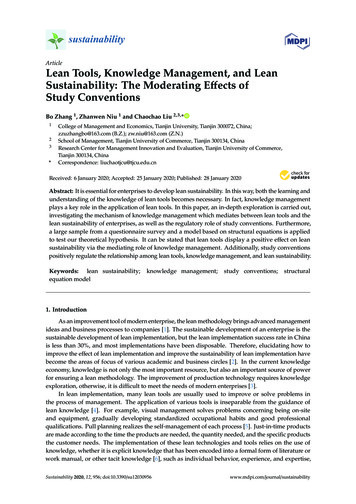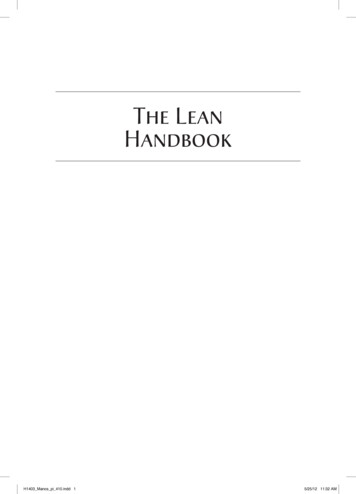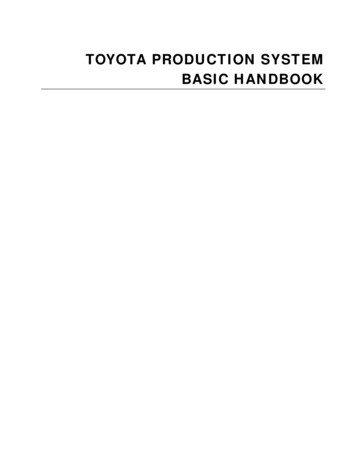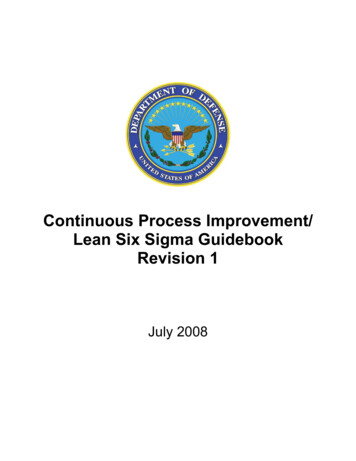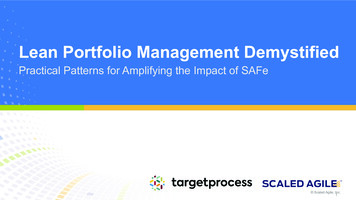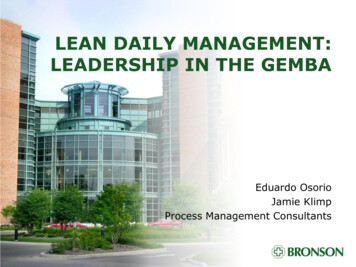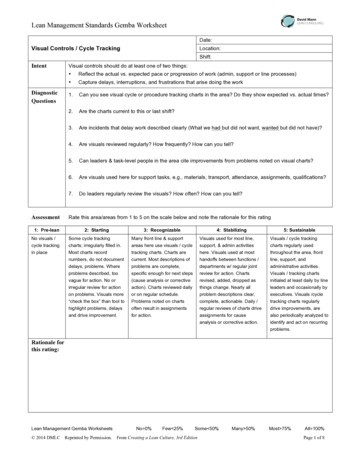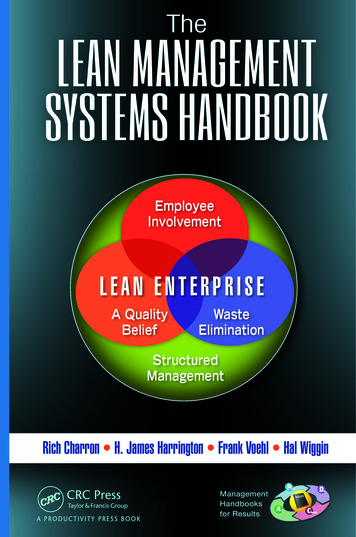
Transcription
TheLEAN MANAGEMENTSYSTEMS HANDBOOKEmployeeInvolvementLEAN ENTERPRISEA ich Charron H. James Harrington Frank Voehl Hal WigginManagementHandbooksfor Results
TheLEAN MANAGEMENTSYSTEMS HANDBOOK
TheLEAN MANAGEMENTSYSTEMS HANDBOOKRich Charron H. James Harrington Frank Voehl Hal WigginBoca Raton London NewYorkCRC Press is an imprint of theTaylor & Francis Group, an informa businessA PRODUCTIVITY PRESS BOOK
CRC PressTaylor & Francis Group6000 Broken Sound Parkway NW, Suite 300Boca Raton, FL 33487-2742 2015 by Taylor & Francis Group, LLCCRC Press is an imprint of Taylor & Francis Group, an Informa businessNo claim to original U.S. Government worksVersion Date: 20140618International Standard Book Number-13: 978-1-4987-0529-5 (eBook - PDF)This book contains information obtained from authentic and highly regarded sources. Reasonable efforts have beenmade to publish reliable data and information, but the author and publisher cannot assume responsibility for thevalidity of all materials or the consequences of their use. The authors and publishers have attempted to trace thecopyright holders of all material reproduced in this publication and apologize to copyright holders if permission topublish in this form has not been obtained. If any copyright material has not been acknowledged please write and letus know so we may rectify in any future reprint.Except as permitted under U.S. Copyright Law, no part of this book may be reprinted, reproduced, transmitted,or utilized in any form by any electronic, mechanical, or other means, now known or hereafter invented, including photocopying, microfilming, and recording, or in any information storage or retrieval system, without writtenpermission from the publishers.For permission to photocopy or use material electronically from this work, please access www.copyright.com(http://www.copyright.com/) or contact the Copyright Clearance Center, Inc. (CCC), 222 Rosewood Drive, Danvers,MA 01923, 978-750-8400. CCC is a not-for-profit organization that provides licenses and registration for a varietyof users. For organizations that have been granted a photocopy license by the CCC, a separate system of paymenthas been arranged.Trademark Notice: Product or corporate names may be trademarks or registered trademarks, and are used only foridentification and explanation without intent to infringe.Visit the Taylor & Francis Web site athttp://www.taylorandfrancis.comand the CRC Press Web site athttp://www.crcpress.com
This book is dedicated to the two most influential women in my lifetime: my late mom, Helen M. (Sharkey) Charron, and my daughter, Hali Charron.To my mom, who selflessly did for me the thousands of things thatmake moms moms. She gave me enough freedom for skinned kneesand hockey game hospital trips, but knew exactly when to step in andprovide course correction before real trouble could become real trouble. I love you and miss you, mom.To my precious daughter, Hali, who as a child opened my eyes to lifelessons that irreversibly changed my understanding of what is important and what is not. As a young woman, she continues to both amazeme and make me proud on a daily basis. Love you, Hali.—Richard CharronThis handbook is dedicated to our friends and mentors: Armand“Val” Fiegenbaum, one of the “Four Horsemen” of the Lean QualityMovement, who never met a problem he could not solve; and toMarshall MacDonald, FPL Chairman, who never met a company hecouldn’t fix.—Frank Voehl
ContentsAuthors. xxiiiChapter 1 Introduction to Lean Management. 1In a Nutshell.1Overview.2Dawn of Lean Manufacturing.3Porsche and the Lean Transformation.4Performance Management.7Raw Material, Work-in-Process, and FinishedGoods Flow.8Operator Flow in Relation to Machines.8Information Flow.9Engineering Flow.9Asset Management.10Resource Management.11Cellular Manufacturing.12Risk Management.14Lean Management System Deployment Model.15Lean Performance Management.15Lean Workers Cross-Training.16Change Management for Senior Management Teams.19In-House Lean Deployment Projects. 20Toyota Lean Management System Explained. 20Lean Management and Green Revolution.24Summary.25References.26Chapter 2 History of Lean. 27In a Nutshell.27Overview.27Lean Techniques. 28Venetian Arsenal (1104–1800).29Eli Whitney (1792–1805).35vii
viii ContentsEli Terry (1772–1852).36Frederick W. Taylor (1856–1915).37Frank Gilbreth (1895–1924).38National Cash Register Company (1896). 40Henry Ford, Sr. (1863–1947). 40Charles Bedaux (1887–1944). 44Walter L. Shewhart (1891–1967). 44Harold F. Dodge (1893–1976) and Henry Romig(1893–1972).45Henry Ford II (1917–1987).45Kaoru Ishikawa (1915–1989). 46Armand V. Feigenbaum (1922–Present).47Taiichi Ohno (1912–1990). 48Shigeo Shingo (1909–1990).49Phil Crosby (1926–2001).50Process Benchmarking (1947–Present).51Joe Juran (1904–2008).52Yoji Akao (1928–Present).52IBM’s 1980s Approach to Quality Improvement.52W. Edwards Deming (1900–1993). 54Total Quality Management (1984).55Eliyahu Moshe Goldratt (1947–2011).55Fast Action Solution Technique (1980).55Malcolm Baldrige National Quality Award (1987). 56Bill Smith (1929–1993).57H. James Harrington (1929–Present) Business ProcessImprovement (1988).59Lean Manufacturing (1988).59Michael L. George (2002).59Jeffrey K. Liker (2012). 60Lean Management Systems (2014). 60Summary.61References.62Chapter 3 House of Lean Management. 63In a Nutshell.63Introduction. 64House of Lean Management.65
Contents ixTransition to the House of Lean Management.67Lean Activity Model.69A Framework for Lean Management Implementation.71Inclusion of Lean Management System Indicatorsand Metrics.74Conditions of a Lean Learning Enterprise.76Lean Socio-Technical System.76Lean Educational System.77Lean Change Management.77Four Pillars of the Lean Management Model.78Summary of the House of Lean Management. 80Five Foundation Stones of the Lean ManagementSystem.81Foundation Stone I: Process ManagementExcellence.83Two Approaches to Process Management.83Foundation Stone II: Project ManagementExcellence. 84Foundation Stone III: Change ManagementExcellence.85Foundation Stone IV: Knowledge ManagementExcellence. 86What Is Knowledge?. 86Foundation Stone V: Resource ManagementExcellence.87Documents Needed for the Lean ManagementSystem Strategic Vision. 88Strategic Vision Sponsor’s Role.89Summary.89Useful References and Associated Readings. 90Chapter 4 Lean Management Systems. 93In a Nutshell.93Overview.94Toyota Challenge.95Views on Toyota’s Management.98Lean Management System. 100Education. 100
x ContentsApplication.102Communication.102Defining Your Lean Management System.103Lean Management System Scorecard.103Learning Management Model (Senge).104Strategy Management Model (Jackson).106Nine Keys to Lean Management System.106Control Points.108How to Score.108About the Score.109Operations Management Model (Shingo).110Shingo Model versus Common Practices.110Summary.112References.113Chapter 5 Lean Socio-Technical System: On Developing aLean Culture. 115In a Nutshell.115Overview.115Lean Culture Defined.117Psychological Human Needs.118Employee Behavior Drivers.119Measures Drive Behavior. 120Beliefs Drive Behavior. 122Motivation Defined. 122Motivation as the Driving Force. 123Fear Drives Behavior. 124Hierarchy of Needs. 126Theory X and Theory Y Management Philosophies. 128Key Social System Implementation Challenges.130Summary.135R
LEAN MANAGEMENT SYSTEMS HANDBOOK Management Handbooks for Results Business Management Performance management, the primary focus of a Lean organization, occurs through continuous improvement programs that focus on education, belief systems development, and effective change management. Presenting a first-of-its-kind approach, The Lean Management Systems Handbook
